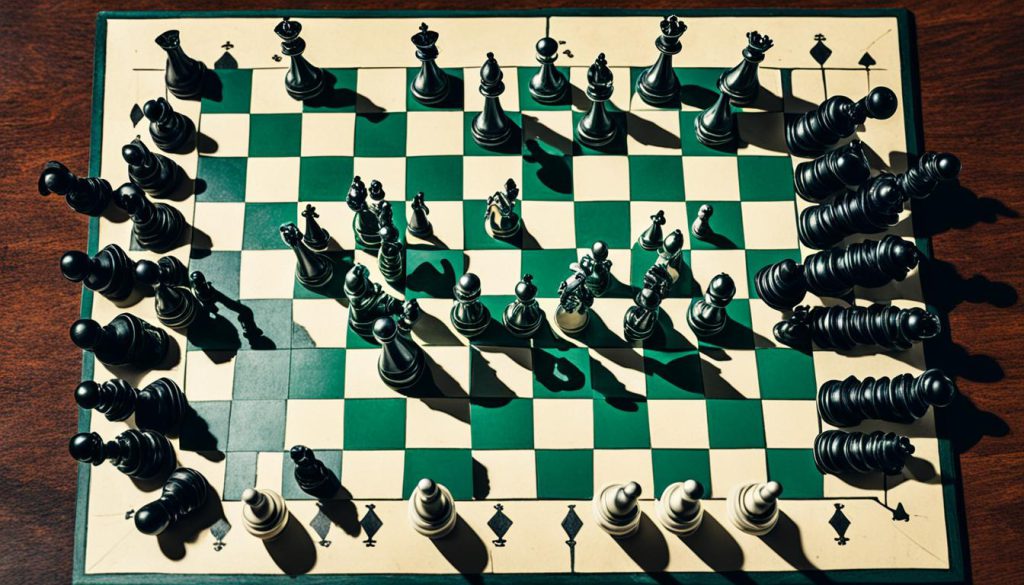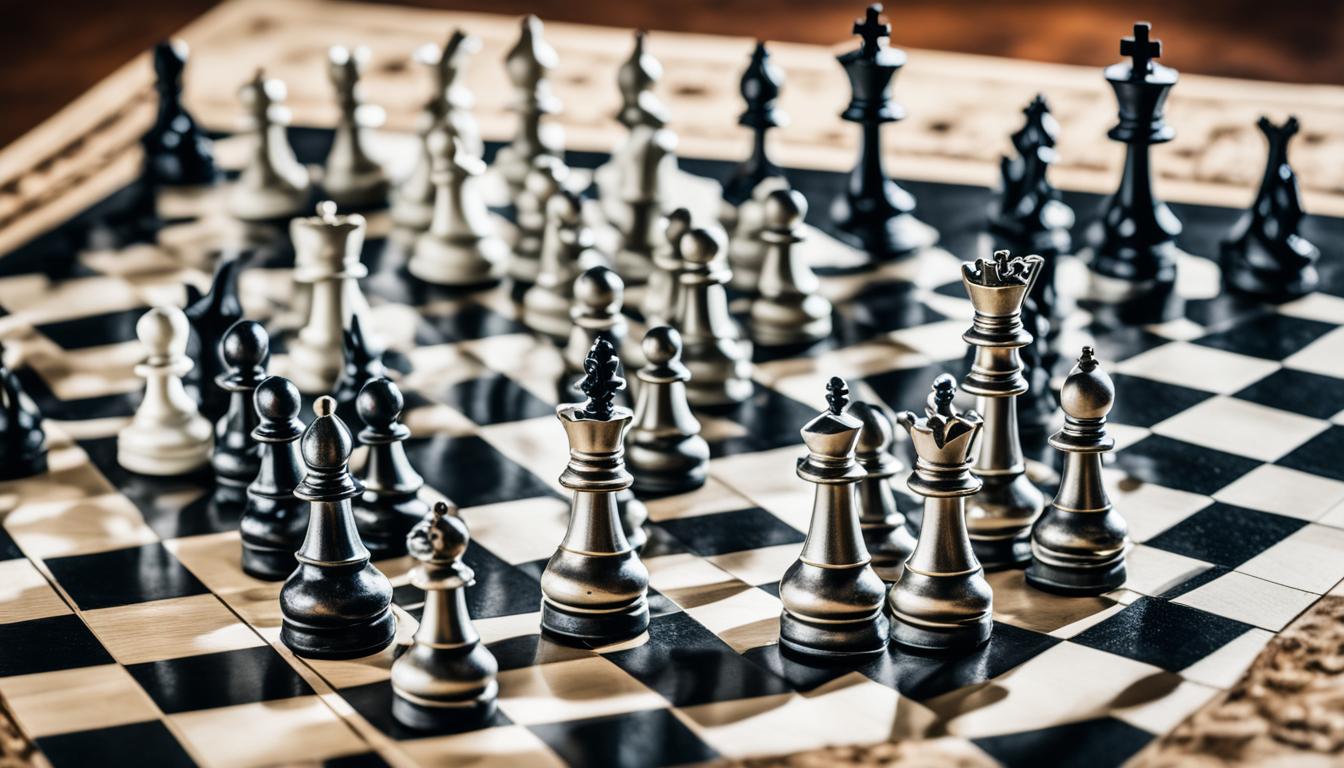Chess is a game of strategy that has been loved for generations. If you’re eager to learn the basics of chess, you’re in the right spot. To get started, you’ll need to understand the board setup, how each piece moves, special rules, how to win, and some basic strategies.
To set up the board, make sure a white square is at each player’s bottom right side. Chess pieces move in unique ways, offering different strategies. For example, the queen is very powerful because she can move in any direction. The king, though the most crucial piece, moves just one square at a time.
Chess has special rules like castling, en passant, and pawn promotion that make it more interesting. Winning at chess means putting the other player’s king in a position where escape isn’t possible. To get good at chess, you need to understand these rules and practice your strategies often.
Key Takeaways
- The white square must be on the bottom right-hand side at the board setup.
- Each piece has unique movements, with the queen being the most powerful but the king the most important.
- Special rules like castling, en passant, and pawn promotion add complexity to the game.
- Checkmate is the objective, achieved by trapping the opponent’s king.
- Strategic thinking and regular practice are crucial to improving your chess skills.
Introduction to Chess
Chess is known as the world’s most popular game, fascinating people of all ages. It is played on a checkered board with 64 squares, arranged in an 8×8 pattern. The white square is always on the board’s lower right side. This classic game has seen a recent surge in popularity due to various factors.
The Rise in Popularity
The resurgence of chess is due to many global events. The COVID-19 pandemic led to a boom in online chess, with many people playing online. “The Queen’s Gambit,” a hit Netflix series, also made chess more popular. Websites like Chess.com have seen a huge increase in users, showing the growing interest in chess.
The Importance of Learning Chess
Chess is more than just a game; it’s a way to build strategic skills and boost your brainpower. Each piece, like the King, Queen, Rook, Bishop, Knight, and Pawn, moves differently. This creates various strategies. For instance, the Queen is the most powerful with 9 points, while Pawns are worth 1 point each. Playing chess can make you better at solving problems and making decisions.
Chess is fun and it helps with mental growth. Winning by checkmate requires sharp thinking and good planning. Players get better by using their pieces wisely, keeping their king safe, and controlling the center of the board. Moves like castling show how deep the strategy in chess can go. This mix of intelligence and strategy is why millions love chess.
Setting Up the Chess Board
Getting ready for a chess game means setting up the board right. It’s essential that the board is set so each player has a white square at their right-hand corner. How you arrange the pieces at the start can really affect how the game goes.
Positioning the Pieces
Setting up the pieces is both organized and meaningful. Pawns go on the second row for defense. Behind them, the rooks, knights, and bishops are placed from the corners. The queen stands on a square of her color, and the king is on the other central square.
- Rooks: Occupy the corners of the first row.
- Knights: Positioned next to the rooks.
- Bishops: Follow next, beside the knights.
- Queen: Placed on her matching color.
- King: Takes the last central square.
The Importance of the White Square
The white square at your right-hand corner is key to setting up the board. This rule is not just tradition; it makes the game consistent. Proper setup means a fair game right from the start, allowing good strategy from the first move.
Chess Basic Rules
Learning chess basics is key if you want to get good at it. Every chess piece moves in its own special way and can capture others. This makes chess a thrilling game of smart moves and careful planning. Knowing how to move and capture with each piece is crucial for winning.
Overview of Movement and Capture
Here’s how each chess piece moves:
- Pawns go forward one square, but two squares on their first go. They take pieces diagonally in front of them.
- Knights move in an L-shape, skipping over other pieces.
- Bishops travel diagonally and stick to their starting color.
- Rooks go straight, forward, backward, or sideways, as far as they want.
- Queens can move like both rooks and bishops, in any direction.
- Kings move one square any way, but not into check.
To capture in chess, a piece moves into a square held by the opponent’s piece. This captures and removes that piece from play.
Standard Turns in Chess
Chess turns happen one at a time. The game begins with the white pieces moving first. This starts the game’s rhythm. Knowing the chess turn order is key for forming strategies and making smart moves.
Here’s a simple table showing how chess pieces move and capture:
| Piece | Movement | Capturing |
|---|---|---|
| Pawn | Forward 1 square (or 2 on first move) | Diagonally 1 square |
| Knight | L-shape (2 squares in one direction, 1 in the other) | Same as movement |
| Bishop | Diagonally any number of squares | Same as movement |
| Rook | Straight lines (forward, backward, sideways) | Same as movement |
| Queen | Any number of squares in any direction | Same as movement |
| King | One square in any direction | Same as movement |
Understanding chess piece moves, capture rules, and turn order helps you build a strong base in the game.
How to Move the Pawn
Chess pawns play a special and key role, though they’re less valued than other pieces. Each side has eight pawns, placed on the second (White) or seventh (Black) rank. Their unique move and capture ways offer strategic challenges and chances.

Pawn Movement Rules
Pawns move in a simple, forward direction, known for their pawn forward motion. On their first move, they can go two squares forward if there’s no block, a move called the first move double-step. Afterward, they can only move one square forward at a time. This movement pattern needs thoughtful planning for effective pawn structure navigation.
Pawn Capture Techniques
Pawns capture in a diagonal way. They take an opponent’s piece by moving one square diagonally, known as diagonal pawn capture. Unlike their forward motion, this adds complexity to their use. Pawns can’t capture straight ahead and they can’t move or capture backward. This limits their flexibility.
Knowing how pawns move and capture can boost your chess strategy a lot. Pawn forward motion and diagonal pawn capture open up many game plans for attack and defense. This makes the pawn a very useful piece for those who know how to use it.
Understanding Rook Movement
The rook is a key player in chess, known for moving in straight lines across the board. With a value of five points, it is crucial in the game’s opening and ending.
Horizontal and Vertical Movement
Rooks can move in straight lines, either across or up and down the chessboard. They can cover the board’s full width and length if nothing blocks their way. Unlike bishops which move diagonally, rooks are versatile in attacking and defending.
Strategic Uses of the Rook
Rooks become very important in the game’s end. They control squares, help pawns become queens, and put the king in checkmate. Placing a rook on the seventh rank disrupts an opponent’s game.
Castling with a rook not only keeps the king safe but also readies the rook for attack. This move improves the rook’s position significantly.
| Piece | Value (in Pawns) | Typical Movement |
|---|---|---|
| Pawn | 1 | Forward 1 square, initial double-step |
| Knight | 3 | L-shaped in any direction |
| Bishop | 3 | Diagonally any number of squares |
| Rook | 5 | Horizontally or vertically any number of squares |
| Queen | 9 | Horizontally, vertically, or diagonally any number of squares |
Mastering rook strategies, like castling and endgame domination, is key to winning at chess. Using rooks wisely can turn a weak position into a winning one. Their power in both attack and defense makes them vital for success.
The Knight’s Unique Movement
When we talk about knights in chess, we notice their special moves. They move in an L-shape, unlike any other piece. This pattern lets them jump over others and escape or attack surprisingly.
Each player starts with two knights, each valued at three points. They move from one color square to another. This helps in attacks like forks where a knight targets several pieces at once.
| Knight Characteristics | Details |
|---|---|
| Movement Pattern | L-shape (two squares in one direction, one square perpendicular) |
| Jumping Ability | Can leap over other pieces |
| Tactical Uses | Delivering forks, smothered mate |
| Value | Three points (equivalent to three pawns) |
The knight’s jump is key for special moves. It can even trap a king in what’s called a smothered mate. Knights can choose from up to eight moves, showing their importance in chess strategies.
Knowing how knights move can really add to your game. It makes them not just unique but very powerful in different situations.
Bishop Movement Explained
Every chess player starts with two bishops: one moves on light squares; the other on dark. Valued at three points, these pieces stick to their color and slide diagonally across the board.
Diagonal Movement
Bishops have powerful control on adjacent diagonals. This is called bishop diagonal dominance. They can travel diagonally as far as they want unless blocked. To use them well, players must think hard about their moves.
Effective Bishop Strategies
Using both bishops effectively is key. This strategy helps find weak spots in the enemy’s defense. The bishop pair is very strong in endgames, controlling large areas.
A “good” bishop has open long diagonals. It’s a big asset in the game. A “bad” bishop might seem weak, but it can still play important roles.
Understanding bishops can really help you win. Managing your bishops well can give you a big edge, especially in complex endgames.
Queen: The Most Powerful Piece
The queen is the most powerful piece in chess, having the abilities of both the rook and the bishop. Her ability makes her key in many plays, both offensive and defensive.
Movement Capabilities
The queen stands alone in her versatility; she moves any number of squares in all directions. This lets her control the game by attacking or defending more squares than any other piece. Unlike the rook and bishop, she covers the whole board with ease.
Her movements allow her to quickly change positions and tackle various situations. She can capture a pawn down the line or check a king diagonally. Her freedom to move is unmatched.
Importance in Attacking and Defending
The queen is vital in strategy because she combines the moves of a rook and bishop. She’s important in both attacking and defending, often deciding the game’s fate. Her mobility lets her launch attacks early or defend strongly.
She excels at blocking threats with her flexible move combinations. For example, a white queen can’t take a pawn on f7 due to a bishop’s block, but she can take one on b7. This shows her ability to adapt to complex scenarios.
| Chess Piece | Value (Points) | Movement |
|---|---|---|
| Queen | 9 | Vertically, Horizontally, Diagonally |
| Rook | 5 | Straight Lines (Files & Ranks) |
| Bishop | 3 | Diagonally |
| Knight | 3 | L-Shaped |
| Pawn | 1 | Forward (Two Squares Initially, One Square Otherwise) |
King: Protecting the Most Important Piece
In chess, the king is the most important piece, yet it’s also weak. It moves one square in any direction but can’t move into check. This shows how critical and vulnerable it is in the game.
Movement and Restrictions
The king’s movement is simple but vital. It advances one square at a time. The main rule is to avoid check, which threatens the king. When in check, the king must react quickly using three strategies:
- Move the king to a safe square.
- Block the attacking piece with another piece.
- Capture the attacking piece.
It’s crucial to follow these rules to keep the game going and protect the king.
Strategies for King Safety
Keeping the king safe is key in chess. An important move is castling for safety. This secures the king and readies the rook for attack. For successful castling, the king and rook must not have moved before, and no pieces should be between them.
Early on, protect the king with pawns and minor pieces. Moving the king wisely in the game’s later stages helps switch from defense to attack. This becomes more important as the game progresses.
| Piece | Movement | Special Moves |
|---|---|---|
| King | One square in any direction | Castling |
| Rook | Horizontally and vertically | Part of castling |
| Queen | Any number of squares in any direction | None |
Even with a strong position, ignoring the king can lead to checkmate and lose the game. Learning the king’s square-by-square move, the check restrictions, and the castling for safety technique is crucial for winning.
Special Move: Castling
Castling in chess boosts king safety and rook activity. It involves the king moving two squares towards a rook. The rook then goes next to the king on its opposite side. This tactic repositions both pieces at once, enhancing defense and movement.

Knowing the rules of castling is key for players. The king and rook used must not have moved before. There should be no pieces between them. Also, the king can’t castle out of or through check. These rules keep the move safe and precise.
Chess has kingside castling and queenside castling. Kingside castling moves the king towards the board’s edge. It makes developing the rook faster. Queenside castling moves the king towards the center. It gives the rook more freedom but needs more setup.
Here’s a quick comparison between the two types:
| Type | King’s Movement | Rook’s New Position |
|---|---|---|
| Kingside Castling | Two squares towards the rook | Next to the king on the same side (shorter distance) |
| Queenside Castling | Two squares towards the rook | Next to the king on the longer side |
By mastering both types of castling, players improve their defense and activate their rooks. This move shows the game’s depth and complexity. Chess is about skill, foresight, and strategic planning.
Special Move: En Passant
The en passant capture adds a twist to pawn movement in chess. It introduces more strategy to the game. This move only happens under certain conditions, making it rare but key for beating your opponent’s strategy.
Key Rules and Conditions
For en passant to work, a few strict rules are in place:
- The opponent’s pawn moves two squares from its start, next to your pawn.
- Your pawn must be three ranks ahead to do the en passant.
- You must make the en passant right after the opponent’s pawn moves. If not, you lose the chance.
- Your pawn cannot have moved four or more squares already.
This rule started in the 15th century to stop easy passed pawns, changing how the game is played. It applies when an opponent’s pawn moves two squares forward, landing on the 5th rank for white or the 4th for black. You capture as if it moved only one square.
Strategic Considerations
The en passant is often seen in grandmaster games, showing its value. By mastering this move, players find new tactical chances and deepen their game. It messes up the opponent’s pawn setup, giving you an edge.
The chance to use en passant must match your game plan and the situation. Practice is suggested to better understand its effect on your game. It makes you think about pawn strategies, adding to chess’s complexity and appeal.
This tactic not only explores pawn moves but also shows chess’s deep tactical nature. It keeps chess captivating and mentally engaging.
Winning the Game: Checkmate
Achieving checkmate is the ultimate win in chess. It means the game is over because the opponent’s king can’t avoid capture. To succeed, you need to know the checkmate conditions well and use your pieces together effectively.
Basic Principles of Checkmate
Getting to checkmate starts with controlling the key squares around the enemy king. This usually requires attacking with several pieces that work well together. For example, by using a queen and rook, you can trap the king in a corner where it can’t move.
Famous Checkmate Patterns
Chess has more than 20 checkmate scenarios to learn. Knowing them can really up your game. For example:
- Fool’s Mate: The quickest checkmate, done in just two moves.
- Scholar’s Mate: A quick four-move checkmate, usually catching new players off guard.
- Back Rank Mate: Takes advantage of a line of pieces in front of the opponent’s king.
- Smothered Mate: Happens when the king is boxed in by its own pieces, with no way out.
- Legal’s Mate: Involves a big sacrifice, losing the queen but securing checkmate.
- Anastasia’s Mate: Often occurs after the opponent has castled.
- Dovetail Mate: The queen pins and checkmates the king.
- Epaulet Mate: The king is stuck because of two pieces on its sides.
From the easy Fool’s Mate to the complex Legal’s Mate, knowing these checkmates can help you win. They show the importance of understanding checkmate conditions.
Also, learning these checkmate scenarios means you can quickly identify them during a game. This knowledge is based on centuries of chess history.
Ending the Game: Draws and Stalemates
Not all chess games end with a checkmate. Many end in draws, especially among skilled players. Knowing how to recognize a draw and understanding stalemates is key for every chess enthusiast.
Conditions for a Draw
Chess has several draw scenarios:
- Stalemate: This happens when a player can’t make a legal move and their king isn’t in check. It’s a clever way to avoid losing.
- Insufficient Material: If neither side has the pieces needed to checkmate, like when it’s just king against king, a draw is called.
- Threefold Repetition: A draw is declared if the same position shows up three times with the same player to move. It stops the game from going in circles.
- Fifty-Move Rule: After 50 moves by both players without any pawn being moved or a piece taken, a draw can be claimed.
- Mutual Agreement: If both players decide there’s no clear path to victory, they can agree to a draw at any time.
Understanding Stalemate
Stalemate is a complex draw situation. It happens when a player has no legal moves but isn’t in check. It’s an immediate draw. Sometimes, it’s used on purpose to avoid loss. Mastering the stalemate can be very useful.
At higher levels, draws are common because players know how to avoid losing. Knowing when and how to claim a draw is a critical part of strategy.
Basic Chess Strategies
In the early stages of a chess match, knowing the chess opening principles is key. These guidelines help us place our pieces effectively. When we control the board’s center and develop pieces well, they work better during the game.
It’s important to know the piece values too. Each piece has a specific value: pawns are worth 1, knights and bishops 3, rooks 5, and the queen 9. The king is priceless and must be protected. Using these values to make smart trades can shape the game.
Mastering board control techniques is another crucial strategy. Controlling important squares lets us limit our opponent’s options. This leads to stronger offense and defense, keeping our pieces potent.
Active pieces are more valuable than many inactive ones. A focused attack can overwhelm an opponent. This is true if they haven’t focused on developing their pieces well.
Understanding the board’s spatial dynamics is also critical. Space behind our pawns gives our pieces more room to move. This increases our options and flexibility. Knowing about pawn structures allows us to plan for the future. These strategies are very important for winning.
Practice: The Key to Improvement
Consistent practice is vital for getting better at chess. It helps improve your strategy, recognize patterns, and make quick decisions. Whether you’re playing chess online or at a club, sticking to regular practice is key.
Benefits of Regular Practice
Practicing often helps you get better strategically. The more you play, the more you’ll understand the game’s deep tactics. Here are tips to boost your chess skills:
- Do chess puzzles every day to improve your tactics.
- Go over your games to spot and fix your errors, making you better overall.
- Learn basic endgames, as they’re crucial for winning.
- Don’t just memorize openings; understand their principles instead.
- Always double-check your moves to avoid costly mistakes.
Utilizing Online Chess Platforms
Online chess platforms offer a world of opportunities. Sites like Chess.com and Lichess.org have features to help you get better:
| Platform | Features | Benefits |
|---|---|---|
| Chess.com | Lessons, puzzles, live games | Improves understanding through structured learning and practice. |
| Lichess.org | Analysis board, puzzles, tournaments | Offers free resources for comprehensive skill enhancement. |
These sites let you play against others around the world, join tournaments, and watch grandmaster games. This significantly boosts your strategy. Regular use can help improve your skills fast, helping you reach new heights like a higher ELO rating through practice and study.
Conclusion
Learning chess rules starts an enriching journey loved by millions worldwide, both for fun and competition. The chessboard has 64 squares in an eight-by-eight grid, filled with pawns, knights, bishops, rooks, queens, and the king. Each game starts with these pieces set up and can end in a win, loss, or draw.
The process of learning chess is more than knowing the moves. It encourages strategic thinking and making smart choices. Players begin with a set lineup of pieces, prompting them to think tactically. Chess offers different game types like classical, rapid, and blitz, each having their own time limits. Players can pick the pace that fits their style, making every game a test of skill and strategy.
Getting better at chess means constant practice and strategic growth. Regular play helps you spot patterns and guess what the opponent will do next. Whether it’s rapid games with 10 minutes each, or blitz with just three minutes, every match is a chance to get better. Putting effort into learning the rules and their uses greatly improves your skill and love for chess. Check out this chess resource for more on the game’s complexities.
Source Links
- https://www.chess.com/learn-how-to-play-chess
- https://www.dicebreaker.com/games/chess/how-to/how-to-play-chess
- https://www.chesshouse.com/pages/chess-rules
- https://en.wikipedia.org/wiki/Rules_of_chess
- https://www.chess.com/terms/chess-pawn
- https://www.chesshouse.com/pages/faq-chess-rules
- https://www.chess.com/terms/chess-rook
- https://en.wikipedia.org/wiki/Rook_(chess)
- https://www.chess.com/terms/chess-knight
- https://en.wikipedia.org/wiki/Knight_(chess)
- https://www.chess.com/terms/chess-bishop
- https://en.wikipedia.org/wiki/Bishop_(chess)
- https://www.chess.com/terms/chess-queen
- https://en.wikipedia.org/wiki/Queen_(chess)
- https://www.chessmatec.com/chess-rules-for-kids-chess-moves
- https://www.chess.com/terms/chess-king
- https://www.chess.com/terms/special-chess-moves
- https://www.chess.com/terms/en-passant
- https://royalchessmall.com/blogs/blog/chess-en-passant-rule-defeat-opponents-with-special-pawn-move-in-chess
- https://www.chess.com/terms/checkmate-chess
- https://chessklub.com/checkmate/
- https://www.chess.com/terms/draw-chess
- https://chessgoals.com/draw/
- https://www.chess.com/terms/chess-strategy
- https://www.chess.com/article/view/how-to-get-better-at-chess
- https://medium.com/@RationalBadger/how-to-get-good-at-chess-9db6d1b5c145
- https://www.chess.com/terms/chess

